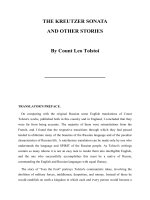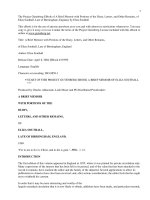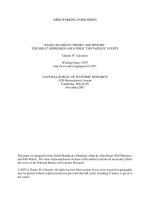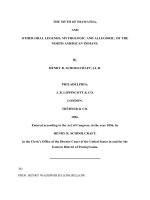The Deseret Alphabet and Other American Spelling Reform Movements
Bạn đang xem bản rút gọn của tài liệu. Xem và tải ngay bản đầy đủ của tài liệu tại đây (4.46 MB, 30 trang )
Utah State University
DigitalCommons@USU
Undergraduate Honors Capstone Projects
Honors Program
1980
The Deseret Alphabet and Other American Spelling Reform
Movements
Paula Goodfellow
Utah State University
Follow this and additional works at: />Part of the English Language and Literature Commons
Recommended Citation
Goodfellow, Paula, "The Deseret Alphabet and Other American Spelling Reform Movements" (1980).
Undergraduate Honors Capstone Projects. 250.
/>
This Thesis is brought to you for free and open access by
the Honors Program at DigitalCommons@USU. It has
been accepted for inclusion in Undergraduate Honors
Capstone Projects by an authorized administrator of
DigitalCommons@USU. For more information, please
contact
THE DESERET ALPHABET
AND OTHER AMERICAN SPELLING
REFORM MOVEMENTS
by
Paula Goodfellow
1
Everyone that uses the English language has trouble
with spelling at one time or another; most people have
trouble with it all the time.
They may complain about the
inconsistencies of English orthography (orthography is a
fancy word for the art of spelling) as they reach for the
dictionary, but not many people do anything about it.
However, a few do try to do something.
become an obsession.
With some it may
This paper is about the various
attempts of some of these people to reform spelling.
It is traditional in papers about spelling reform to
stop at this point and prove to the reader just how incon
sistent English orthography really is, usually through some
device such as listing all the sounds that the letter "a"
can represent or all the ways there are to represent the
sound/s/.
But I'm not going to do that.
You may stop and
reflect about these inconsistencies if you wish.
When someone gets the urge to reform English spelling
he goes about it in one of two ways.
Either he tries to
work within the existing alphabet and just get rid of
those spellings that particularly irk him, or he tries to
invent a whole new- alphabet in which each letter will rep
resent one and only one sound and no sound may be repres
ented in more than one way.
The first method is usually
called Simplified Spelling; the second usually produces
something called a phonemic alphabet.
Simplified spelling
reformers include such people as Benjamin Franklin, Noah
Webster, Melville Dewey, Mark Twain, and Theodore Roosevelt.
2
Phonemic reformers include George Bernard Shaw, Isaac Pitman,
Brigham Young, and Benjamin Franklin and Mark Twain again.
The earliest American spelling reformer was Benjamin
Franklin.
Franklin designed a new alphabet in which each
letter would correspond to one phoneme and each phoneme
would be represented by only one letter. 1
He planned to
write a book that was to be called A Scheme for a New Alpha
bet and a Refa:med Mode of Spelling, for which special
printing plates in his alphabet were to be made.
This book
is not listed in any catalogue of books, so apparently
plans for it were never completed.
He enlisted the aid of
his friend Noah Webster, and it was through Webster that
spelling reform achieved its greatest success.
It is interesting to look at a defense of spelling re
form by Franklin in a letter to Mary Stevenson who attacked
his reforms because the attacks and the defense are the
same ones that come up in later attempts at reform.
First
Stevenson says that it would be a great inconvenience to
have to learn a whole new alphabet.
Franklin counters by
saying that the new system of spelling would be easy to
learn by those that spell well because the letters would
represent the sounds and one would only have to write what
he heard.
He said that it would be especially easier for
bad spellers to learn since they already spell by sound.
He says that many people use the current system all their
lives and still do not learn it well.
He also said that the
sound of the language was growing farther from the written
J
form all the time, so that the problem would only worsen.
He adds that the new spelling would help foreigners to
learn the language more easily because they could learn
pronunciation from books.
She had also complained that the
etymologies would be lost.
He said that the etymologies
were already undetectable in many words.
The etymologies
would still be preserved in old books, and Franklin felt
that anyone who was really interested in them could find
them in the books.
He felt that the history of a word was
not really important anyway, only its current usage.
Stevenson also thought that the new alphabet would
cause difficulties because the difference in meaning of
homonyms would not be shown.
Franklin said that they were
not present in speech, and if a person could tell the dif
ference in rapid speech, he certainly should be able to in
writing.
Last she mentioned that it would cause great
waste because all the books then published would become
useless.
He said that this was not the case, because this
change was to happen over a long period of time, and all
these books would still be read by people who had learned
the old orthographyi
Regardless of all these arguments in
its favor, Franklin's new alphabet did not succeed as well
as his other inventions, and he turned to Noah Webster to
implement a lesser type of reform.
When Franklin first tried to interest Webster in spell
ing reform, Webster was not interested.
In fact, he criti
cized spelling reformers in his 178) book, Grammatical
4
Institutio. 3
But by 1789 he was in favor of it and pro
moted the subject in his book Dissertations on the English
Language.
He introduced a system of simplified spelling.
He is the person responsible for many of the differences
in English and American spellings today.
He tried to go so
far as to drop some silent vowels as the "a" in bread and
to write "ee" for the vowel sound in words like�.
speak, grieve, and key.4
He also tried to drop the final
"e" on words such as determine, examine, doctrine, and med
icine.
These reforms were not accepted , but some of his
other reforms were.
In his first dictionary, A Compendious
Dictionary of the English Language, printed in 1806, he
made several changes in orthography.
He left the final "k"
off of some words like music, physic and logic.
However,
he was not always consistent; he left the old spelling in
traffick, almanack, and frolick.
He also changed the
spelling of words that ended in "re".
So sceptre became
scepter, theatre became theater, and metre became meter.
He substituted "k" for "que" leaving us with check, mask
and risk. 5
Many of Webster's spellings have been accepted into
American usage.
This was not true of the attempts of other
later reformers who tried to simplify the spelling.
Since
the reforms were of the same nature it seems that the other
simplified spelling should also be accepted.
not.
But they were
At a closer look, one finds that Webster had an extra
advantage.
He was lucky enough to live at a time when
5
American culture was just being built.
His dictionary of
1806 was the first American dictionary of note.
Since it
was regarded as an authority, many of the spelling reforms
that were included in it have survived.
Webster's An
American Spelling Book, known to several generations as
"the blue-backed speller," was the book used by most schools
in spelling instruction until well into the middle of the
nineteenth century.
The students were usually required
to memorize the words and spell and pronounce them cor
rectly for their teacher.
It is not surprising, given
the popularity of this speller, that many of Webster's
reforms were accepted.6
Melville Dewey, the inventor of the Dewey Decimal sys
tem, also devised a form of simplified spelling.
His reform
does not seem to have made too much of an impact, on
anyone, because no mention is made of it in the books that
mention spelling reform, but a sample of it can be found
in the introduction to the fifteenth edition of the Dewey
Decimal system.
The entire thirteenth edition of the
Dewey Decimal system was written in this system, which is
probably the reason that not many libraries still have
their thirteenth edition.
His system was almost an attempt
at phonemic spelling, but since he retained the Roman
alphabet, a real phonemic system was impossible.
This lead
to some inconsistencies in his spelling such as the use of
"y" in byers for buyers and in rapidly.
This is just one
case of many when he used the same letter to represent two
6
different sounds.
Also there are some instances when he
had two different ways of spelling the same sound such as
the /i/ phoneme in skeme for scheme and means.
Some of his
other reforms included using either "t" or "d" to form the
preterite instead of "ed" and always using "k" to represent
/k/.
It was
Dewey system was elaborate and inconsistent.
too complex to learn by rote, and too arbitrary to simply
spell by sound.
The Simplified Spelling Board, instituted by order of
Theodore Roosevelt in 1906, was an attempt to legislate
spelling reform.
This board was to make recommendations
about which words should have their spellings simplified.
It was not an attempt at phonetic spelling.
Roosevelt prob
ably got the idea for the board from his friend, Brander
Matthews, a linguist who was concerned with the issue of
spelling reform.
Matthews, a professor at Columbia Univer
sity, was made the head of the board.
Other members of the
committee were Nicholas Murray Butler, president of Stanford
University; William James, author and psychologist at
Harvard; Mark Twain; Thomas R. Lounsbury, professor of
English at Yale; Isaac Funk, editor of the Standard Dic
tionary; and Richard Watson Gilder, editor of Century Mag
azine.
The board was supported by funds from Andrew
Carnegie. ?
In 1906 the board came up with a list of
that they felt should be simplified.
JOO
words
They included such
reforms as medieval for medaieval, honor for honour, plow
7
for plough, program for programme, judgment for judgement,
and tho and thru for th>w;h and through.
reforms were accepted eventually. 8
In
Some of these
190 6
Roosevelt
instructed the government printing office to publish all
government documents with the new spelling. 9
But the new
spellings were ridiculed in the public press and by Congress. 10
More lists were published over the years until
new forms were rarely recognized by the public.
gradually died out.
1 93 1,
but the
The program
Many of the public objections were the
same as those given to Benjamin Franklin about his new
alphabet.
Some people even preferred the difficult spelling
because it served as a social indicator; correct spelling
was seen as a sign of intelligence by many people.
If
spelling were simplified, then one social distinction would
be lost. 11
Many of the phonemic reformers based their alphabets
on the work of others.
The ''Philosophical Alphabet" of
Jonathan Fisher was not closely related to any of the other
reform attempts.
Fisher was a New Englander, born in the
eighteenth century, and educated at Harvard.
He was inter
ested in Linguistics, having learned Hebrew, Greek, Latin
and French, and wrote several works describing the various
phonemes in English as he perceived them. 1 2
had diverse interests.
Fisher also
He was primarily a minister, but
was also a farmer, artist of some note, surveyor, and
author. 1 3
autumn of
His philosophical alphabet was designed in the
1792
while Fisher was still a student at Harvard.
8
Fisher used it to save time and paper and used it in his
personal papers for the remaining fifty years of his life.14
The alphabet seems to have been for Fisher's personal
use only.
It seems to have sprung from his linguistic
interests and a desire for utility, not from any zeal to
reform the language.
It is now of interest mainly to
linguists, who use the alphabet to study the dialects of
New England at his time.
Most of the symbols in Fisher's
alphabet were taken from the style of orthography of his
day.
Some came from earlier phonetic alphabets and some
seem to have been invented by him,15
Fisher used a single
symbol for each of several sounds that are represented in
Ii
conventional orthography by two symbols,
Is I, /1_ I, I,
1, /, /el, lo/. 16 This was one of the best innovations in
his alphabet.
The inspiration for many of the spelling reform move
ments of the nineteenth and twentieth centuries came from
the work of an Englishman, Isaac Pitman.
He was also the
inventor of the basis for modern shorthand.
published Stenographic Shorthand 1 7
In 1837 Pitman
This system was mostly
intended to be a rapid system of writing, not as a means of
reform.
But Pitman was also interested in spelling reform
for the general public,
He and a linguist, Henry Ellis,
attempted to adapt the stenography so that it would be
acceptable as an alphabet for general use.
They printed a
journal, Phonotypic Journal, about spelling reform for
several years and the Bible and some classical works were
9
printed in their alphabet. 1 8
The alphabet, like the other
attempts at reform, did not receive much attention from
the public, but it did not really die out either.
It was
remembered by the few groups of people in the world that
thought that spelling reform was a burning issue.
It was
revived and revised several times in later years by the
Mormons in their Deseret alphabet, by George Bernard Shaw
in his Shaw alphabet, and by Pitman's grandson James in
the Initial Teaching Alphabet.
Mark Twain proposed using
Pitman's alphabet because it would be even better than the
simplified spelling movement. 1 9
George Bernard Shaw, the British playwright, was great
ly concerned with both written and spoken language.
The
pronunciation peculiarities of Englishmen and Americans
greatly offended him, and he wanted to set up some sort of
means of correcting these offenses.
He saw himself as a
great Henry Higgins out to reform a world of Eliza Doo
littles.
He wanted to find a system of orthography that
would represent the actual phonemes of the language and
establish a standard of English pronunciation.
He also
thought that a new alphabet could save time and space in
printing.
He was a friend of James Pitman, and they worked
together on the reform.
Shaw believed that Isaac Pitman's
alphabet proved several thingsa
that a forty letter alpha
bet would work to represent English sounds, that a new
alphabet could be accepted because the Pitman system had
spread around the world, and that anyone who wanted to
10
learn a new alphabet could do so.20
Shaw used the Pitman
system in his own writing.
Shaw was convinced that the new alphabet required
forty symbols to represent English accurately,
There were
postcards printed to promote his reform ideas, and they con
tained an explanation of how he had arrived at forty.
First
he said that there were twenty-six characters in the Roman
alphabet, but three of them were unnecessary so that left
twenty-three sounds.
Then he said that seven new consonants
were needed to represent the sounds sh, zh, wh, ch, th, dh,
ng, and ten new letters were needed to represent various
vowels and diphthongs.
This added up to a total of forty.21
The Pitman system contained forty letters, but for
some reason Shaw did not want to use this for his new alpha
bet.
He did not invent symbols for one himself either,
although it seems that it would be easy enough since he
knew what sounds should be represented.
Instead he set up
a trust in his will that provided for a foundation that was
to find the new alphabet through a contest and give prize
money to the winner.
The will was contested by family
members and friends who thought that they could find better
uses for the money than spelling reform.
The court took
away most of the prize money for the foundation, but the
contest was still held.22
Finally in 1962, seven years
after Shaw's death the alphabet was revealed to the public.
It was a composite of four of the best entries and con
tained forty-eight letters.
It was not noticed by the public,
11
and only one thing was printed in it, The Shaw Alphabet
Edition of Androcles and the Lion. 2J
The Economist said
that it would not work because of the cost involved and the
difference in English dialects.
Shaw felt that the transition from Roman letters to
the Shavian would be like the transition from Roman numer
als to Arabic; it would make reading easier and save space.
He wanted to do away with the differences between capital
letters and small letters and between printing and hand
writing.
The Deseret Alphabet that was designed by the Mormons
in Salt Lake City was also influenced by Pitman's phono
graphy.
George D. Watt, a convert to the church from
England, came to Nauvoo, Illinois in 184).
He was familiar
with the Pitman system and used it to transcribe minutes of
church meetings.
Brigham Young became interested in this
system, and the idea of instituting spelling reform may
have occurred to him even then. 2 4
until the Mormons came to Utah.
But the idea had to wait
The first mention of spell
ing reform was made by Brigham Young in a speech on April 8,
185).
He spoke out against the inconsistencies of conven
tional orthography at this time. 25
That year the Board of
Regents of the University of Deseret appointed a committee
to oversee the development of a new alphabet. 2 6
It is not known exactly who was responsible for the
design of the new alphabet or where the characters came
from.
H. H. Bancroft said in his History of Utah that the
12
letters of the alphabet were like some of the characters
that The Book of Mormon plates were in.
He also says that
some of the writing of The Book of Mormon plates contained
Greek letters, so some of the characters in the Deseret
alphabet looked Greek.
27
In comparing copies of the Deseret
Alphabet to extant copies of The Book of Mormon script, some
similarities can be seew.
Mostly the similar characters are
the ones that are similar to Greek letters also.
The Book of
Mormon characters do not seem to be an important source for the
Deseret Alphabet.
Brigham Young's secretary, T.W. Ellerback,
wrote that G.D. Watt designed the alphabet and that he designed
some of the characters himself and took some others from the
ancient alphabets shown in Webster's unabridged dictionary.
28
Hosea Stout wrote in his journal in March, 1854, that George D.
29
Watt was responsible for working out the characters.
Jules Remy,
a French visitor to Salt Lake City said that the alphabet
3
originated with W.W. Phelps. °
Floris Springer Olsen said in
Early Ninteenth Century Shorthand Systems and Possible Similarities
Between Any of Them and the Deseret Alphabet that some of the
characters in the Deseret Alphabet could be traced to Pitman
characters.
the alphabet.
This would indicate that Watt was responsible for
Most of the evidence indicates that Watt probably
did most of the work on it.
By 1855 the alphabet was being taught to the clerks
in the Church historian's office
31
and in Marc� John Milner
taught the alphabet to several hundred people in the Provo
13
area. 32
On July
3 1,
1855 the subject of the new alphabet
was discussed by the Deseret Typographical Association and
a committee was appointed to draft a resolution stating
the opinions of that august body on the alphabet.
Since
the committee consisted of George D. Watt, W. W. Phelps,
and Jason McKnight, two of whom were involved on designing
the alphabet, the resolution was bound to be favorable. 33
At the Associations next meeting the resolution was read.
It is interesting for the insights into the motives behind
the Deseret Alphabet that it gives.
It stated that English
orthography was imperfect and inadequate, but the Deseret
Alphabet supplied simple characters for the simple sounds
of the human voice that would correct those "absurdities."
It said that the new alphabet would make pronunciation more
definite and make it easier to learn foreign languages and
lessen the trouble of learning to read.
It is unclear what
was meant in saying that it would make foreign languages
easier to learn, perhaps they meant that learning phonemic
alphabet would help to learn other languages whose alphabets
were phonemic, but it is more probable that they meant the
Deseret alphabet would aid the large number of immigrants
that were entering Utah to learn the language.
Finally
the resolution stated that the association should hail the
alphabet as a "forerunner in that series of developments in
philology which shall prepare man-kind for the reception
of a pure language."
Also the resolution stated that
George Watt should be asked to teach the new alphabet to
the Association. 34
14
The new alphabet began to be promoted in earnest.
On
October 4, 1855, Robert Campbell exhibited a letter written
in the Deseret Alphabet to the Deseret Typographical
Association.
This letter was remarkable because it was
said to have been written by a missionary who had no know
ledge of traditional orthography, but had written this
35
letter after only six lessons in Deseret script.
The
territorial legislature appropriated $2500 for the purpose
of getting some school primers printed on December 28, 1855.
On February 4, 1856, President Young met with the Board of
Regents and appointed a committee to write the first two
primers in Deseret Alphabet.
George D. Watt, Samuel
Richards, and Wilford Woodruff were the original committee
members.
By February 25 the work was not progressin�
quickly enough to satisfy President Young, so three new
committee members were appointed:
E. Smith, Parley P. Pratt,
and Orson Pratt.
There seems to have been a fair amount of public support
for the new alphabet even though nothing had yet been
printed in it.
it
36
Jules Remy reported seeing shop signs using
and the tombstone in Cedar City of John Morris, who died
April 8, 1853, was carved in Deseret Alphabet.
37
In a
July 24 celebration at North Willow Creek in Box Elder
County in 1855, two small boys marched in the parade
38
carrying a representation of the alphabet.
The primers
were not printed at this time however, probably because the
type had not been procured.
The alphabet was laid to rest
for several years because of the "Utah Wars."
15
After the excitement, on November 20, 1858, it was
discovered that the work that had previously been done on
the primers had been lost, and Brigham Young appointed Watt
and Woodruff to compile some more books.
The Board of
Regents began to make arrangements for the printing of the
texts. 39
But the work does not seem to have progressed
much, because no mention is made of them in Journal History
until May 22, 1862 when Robert Campbell came to Brigham
Young with a proposal to print the school readers in common
type.
President Young said that "he would not co�sent
to have his type, ink, or paper used to print such trash
(which he considers such work to be, seeing that they are
in the English characters.)
ters to be patronized."
He wishes the Deseret charac
There was some activity in
Deseret Alphabet at this time.
The Deseret News printed
readings from the Bible once a week from February 16, 1859
to May 2, 1869 when they were discontinued without any
explanation.40 They were revived again for a brief time
in 1864.
Also several committees worked at adapting the
alphabet and deciding on pronunciations of various words.
The influence of Brigham Young in planning the alphabet is
shown in the Journal History entries of this period because
he was present at nearly every meeting.
Some work was done
on transcribing Webster's Dictionary into Deseret Alphabet,
but it was discontinued because of expense.41 For some
reason the interest in the Deseret Alphabet died out until
1868, and no mention is made of the alphabet in Journal
16
History until then.
In May 1868 Campbell gave Orson Pratt
material to transcribe into Deseret Alphabet for the
primers.
He must have worked quickly because by June 25
the second book had been sent off to the printer in New
York by Wells Fargo Express.42
Throughout the next two
years there was a great effort by the Regents and the
Deseret News to promote use of the books in the schools
through editorials and travel to various districts in the
state,43 but public support was lacking.
There were no
public schools so use of the alphabet could not be forced
by the government.
By the end of 1870 the advertisements
for the primers that had been carried in the Deseret News
were discontinued.44
The last mention of the alphabet in
this period in the Journal History is a letter from Orson
Pratt to the territorial legislature asking for $6537.87
for his work in transcribing the Doctrine and Covenants
and the Bible into Deseret Alphabet, having written 3996
foolscap pages.
Spelling Reform seems to be a strange subject for a
group of people trying to build a city in the desert to be
bothered about.
There is not really one single reason that
caused Brigham Young to be so concerned with reform, instead
there were many reasons.
As was already mentioned, one of
the motivations was the belief that someday there would be
a great reform in language and a perfect language would be
restored to the earth.
This is born out in the resolution
of the Deseret Typographical Association that says that the
17
Deseret Alphabet was just a step in this great reform.
Brigham Young felt that young children should not be forced
to spend a long time sitting quietly in school "on a hard
bench until they ache all over."
He thought that they
should have more time to move around and do things that
interested them.
He thought that the Deseret Alphabet would
make it easier for children to learn to read so that they
wouldn't have to spend so much time in school.
to have been one of his major motivations.
This seems
He also told
the Board of Regents that the alphabet could aid foreigners
in learning English.45 Another theory is that the alphabet
could have been designed to keep the children of Deseret
protected from outside influences.46
There were also many reasons for its failure.
One
certainly was the lack of money that is mentioned many
times through out Journal History entries about Deseret
Alphabet.
Brigham Young said that one of the problems was
that the people knew the old system and did not want to
change.
He felt that that problem could be solved if the
children were instructed in the new alphabet.47 A. J.
Simmonds mentioned the fact that the primers were printed
about the same time that the transcontinental railway was
completed.
The railroad made more books available to the
pupils and destroyed the isolation that could have made the
alphabet successful.
Finally the death of Brigham Young,
the alphabet's strongest proponent, robbed it of its
driving force.
18
The many failures seem to show that spelling reform
is a hopeless cause.
The expense and time involved in
making a change always seem to outweigh the benefits of a
reform.
It is also difficult to institute a good consis
tent reform.
Phonemic reforms cause difficulty because
speakers of English everywhere have different dialects, and
a widespread phonemic reform would probably cause more
trouble than it would solve as each person tried to write
the way he spoke.
Since there is no body to legislate
language rules for English as there is in France, simplified
spelling changes will probably also be slow in coming.
Finally, perhaps spelling should not reflect speech totally
after all.
A linguist, Henry Bradley, said that writing
was not simply to represent sounds, but to many people it
conveys meaning without the intermediary of mental pronun
ciation, so the difference in some words helps one�s
standing in reading.48
under
If this is true perhaps spelling
reform is not needed or good.
19
FOOTNOTES
1Benjamin Franklin, The Papers of Benjamin Franklin,
ed. William B. Wilcox (New Haven and London: Yale Univ.
Press, 1972), 15:173,
2Noah Webster, Dissertations on the English Language
(Gainesville, Florida, Scholar's Facsimiles and Reprints,
1951 ), p • 408 •
3Albert C. Baugh, A Historv of the English Language,
(New York, 1957), p. 429,
4Ibid,, p. 4JO.
5Ibid.
6Abraham Tauber, ed., Geor e Bernard Shaw on Lan ua e
(New Yorks Philosophical Library Inc., 19 J , pp. 4J1-4J2.
7c1yde H. Dornbush, "American Spelling Simplified by
Presidential Edict," American Speech, J61 236-8.
8rbid.
9Ibid.
10Baugh, Ibid., P• J89.
11American Speech, 35: 124-JO.
12Raoul N. Smith, "The Philosophical Alphabet of
Jonathon Fisher," American Speech, .50, 37.
1Jibid., p. J8.
t4rbid.
15rbid. p.
16rbid.
4o.
17 Baugh, Ibid., p. J88.
tsrbid.
20
19Mark Twain, The Complete Essays of Mark Twain, ed.
Charles Neider (Garden City, New Yorks Doubleday and Comp
any, Inc., 196 3), p. 544.
20Tauber, Ibid., p. 18
3
21Ibid., p. 6 .
3
22Ibid., p. 164-70.
23"Shaw's Alphabet, Ploys Unpleasant?" Economist, 205:754
24The Deseret Alphabet, Utah Historical Quarterly,
121 98-102
25s. s. Ivins, "The Deseret Alphabet, Utah Humanities
Review, 11223-239.
26A. J. Simmonds, "Utah's Strange Alphabet,"True Front
ier, Nov. 1968, p.28
27Hubert H. Bancroft, History of Utah, (San Francisco,
The History Company, 1890), p. 712-3.
28samuel C. Monson, "The Deseret Alphabet," Utah Acad
emy of Sciences, Arts, and Letters Proceedings, 301 23-9
29Hosea Stout, Journal of Hosea Stout, ed. Juanita
Brooks (Salt Lake City, Utah, University of Utah Press,
1964), 2: 509.
30Jules Remy & Julius Brenchley, A Journey to the Great
Salt Lake (London 1861), 21 185
31Journal History of the Church of Jesus Christ of Latter
Day Saints on microfilm in Special Collections at Utah State
University, Feb. 7, 1855.
323.H., Mar. 11, 1855.
33J.H., July 3, 1855.
343 .H., Aug. 2, 1855.
35J.H., Oct. 5, 1855-
36Remy, Ibid., p. 185
37Monson, Ibid., P• 25.
38J,H,, July 24, 185539J.H., July 25, 1855-
21
40George o. Rampton, "The Deseret Alphabet," unpublished manuscript in USU special collections, appendix.
41J.H., April 14, 1859.
42J.H., June 25, 1868.
43J.H., Undated.
44Rampton, Ibid., p. 13
45J.H., Jan. 31, 1859.
46simmonds, Ibid.
47J.H., Sept. 7, 1862.
48Baugh, Ibid., P• 310
22
BIBLIOGRAPHY
American Speech. J5s124-JO
Bancroft, Hubert H. History of Utah. San Franciscos The His
tory Company, 1890.
Baugh, Albert C. � History of the English Language. 2nd ed.
New Yorks 1957.
Dornbush, Clyde H."American Spelling Simplified by Presi
dential Edict." American Speech 36, 236-8.
Economist, 'rhe. "Shaw's Alphabet, Ploys Unpleasant?"
.205 (Noy. 24, 1962),754.
Franklin, Benjamin. The Papers of Benjamin Frnklin. William
B. Willcox, ed. New Haven and Londons Yale University
Press, 1972.
Ivins, S.S. " The Deseret Alphabet." Utah Humanities Review
1s 22J-J9.
Journal History of the Church of Jesus Christ of Latter-Day
Saints, Microfilm in Utah State University Special Col
lections.
Lounsbury,
Thomas R. The Standard of Usage in English and
'
English Spelling and Spelling Reform. New York11909.
Monson, Samuel c. "The Deseret Alphabet." Utah Academy of
Sciences, Arts and Letters Proceedings JO, 2J-9.
Olsen, Floris Springer. Early Nineteenth Century Shorthand
Systems and Possible Similarities Between Any of Them
and the Deseret Alphabet. Unpublished Master's Thesis.
Utah State Agricultural College. 1952.
Proudfit, C.L. " Lander's Hobbyhorses A Study in Romantic
Orthography." Studies in Romanticism 7• 207-17.
Rampton, George o. The Deseret Alphabet. Unpublished manu
script in USU Special Collections.
23
Remy, Jules, and Brenchley,
Julius. ! Journey to Great Salt
Lake City, 2 vols. 1 London118611
Simmonds, A.J. "Utah's Strange Alphabet" True Frontier Nov.
1968.
Smith, Raoul N. "The Philosophical Alphabet of Jonathan Fisher"
American Speech 50136-49.
Tauber, Abraham, ed., George Bernard Shaw .Q!! Language
York,Philosophical Library Inc. 1963.
New
Twain, Mark. The Complete Essays of Mark Twain Charles Nei
der, ed., Garden City, New Yorks Doubleday and Company, 196J.
tlebster, Noah. Dissertations .Q!! the English Language Gainsville
Florida, Scholar's Facsimiles and Reprints, 1951.









